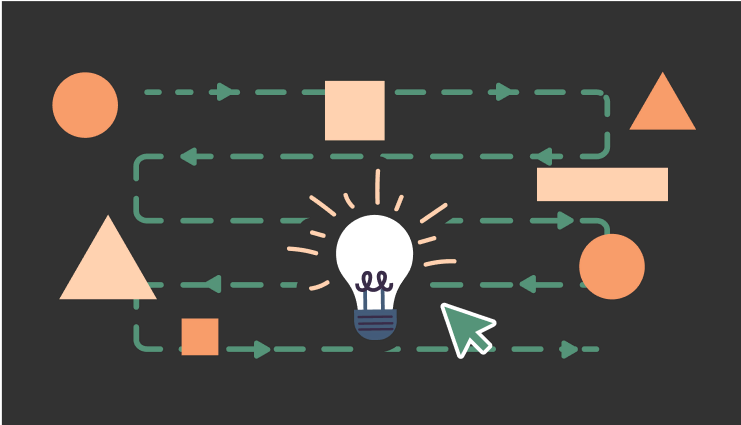Enter the ADDIE Model – a proven, data-backed approach that has revolutionized instructional design worldwide. What sets ADDIE apart? The ADDIE Model reigns supreme for three compelling reasons:
- Unparalleled Adaptability: The ADDIE Model’s greatest strength lies in its adaptability. Whether you’re crafting training for a corporate team, a classroom of students, or global online learners, you can tailor ADDIE to fit any context.
- Precision at Every Phase: ADDIE’s systematic approach is a hallmark of its success. With distinct phases covering Analysis, Design, Development, Implementation, and Evaluation, it leaves no room for guesswork.
- Continuous Improvement: The ADDIE Model isn’t just about designing a course; it’s about continuously enhancing it. Through the Evaluation phase, you gather feedback, identify areas for improvement, and refine your training materials. This iterative process ensures that your courses evolve alongside the ever-changing needs of your learners.
The Acronym “ADDIE”
At the heart of the ADDIE Model lies a simple yet powerful acronym that encapsulates its systematic approach to instructional design services. ADDIE stands for:
- Analysis: This is the phase where you assess the needs and goals of your learners and identify any potential challenges or constraints. It’s all about understanding the who, what, and why of your training program.
- Design: In the design phase, you take the insights gathered from the analysis and outline the structure, content, and objectives of your training. This is where the blueprint for your course takes shape.
- Development: Here, you bring your design to life by creating the actual training materials, whether they be physical resources, digital content, or interactive modules. Development is the hands-on phase where your course comes to fruition.
- Implementation: During the implementation phase, your training program is introduced to the intended audience. This stage involves putting your thoughtfully designed materials into action, whether through in-person sessions or online platforms.
- Evaluation: Lastly, evaluation involves assessing the effectiveness of your training program. Did it meet its objectives? Were learners engaged and satisfied? This phase is crucial for continuous improvement.
In a nutshell, ADDIE is your roadmap to designing effective and learner-centric training programs. It guides you through a logical sequence of steps, ensuring that your educational initiatives are not only well-structured but also consistently impactful. To make each phase of the ADDIE model easier to manage, explore these instructional design tools that simplify your workflow.
Section 1: Analysis
In the Analysis phase of the ADDIE Model, you, as an instructional designer, must identify the needs and characteristics of your future learners. Simply put, understand — based on data, not assumptions: Who your learners will be? What will they learn? What should they be able to do by the end of the course?
If you were tasked with creating a comprehensive safety training program for a manufacturing company, where would you start? Of course, before you could create the first slide of the course material, you would delve deep into the workplace. At this stage, you need to interview employees and review incident reports.
The goal at this stage is to unveil potential risks and understand the knowledge gaps. Without it, you will not reach the safety and well-being of all employees.
Section 2: Design
As you move into the next phase, the Design phase, all of your insights and conclusions from the previous Analysis phase will serve as the foundation for your course.
It’s still too early to create content, but now is the time to make key decisions — what the final course will look like and how it will work for your learners.
The main goal of the Design phase is to map out the learning path, plan materials, and decide how the content will be delivered.
Start by writing clear learning objectives. Many experienced instructional designers and independent educators use Bloom’s Taxonomy to define the right level of cognitive skill for their audience. For example, should learners remember, apply, or evaluate? Next, it’s a good idea to set SMART goals at this stage. Instead of vague course goals, define clear, measurable outcomes.
Example: “By the end of this article, the reader will be able to summarize the five steps of the ADDIE model.”
After all, you can build the course outline: 1. You should choose content types (videos, readings, quizzes). 2. Decide the order of modules. 3. Define feedback and assessments. Also, consider accessibility and pacing — how much time should each part take?
Section 3: Development
D stands for Development, and it’s time to translate your learning goals into content that’s ready for learners.
Now that your course structure is complete, the Development phase of the ADDIE Model is where you build it out. You start creating the actual learning materials based on your design plan.
Your steps at this point: write scripts, record videos, build slides, and develop assessments. You’ll also need to test interactivity, visuals, and technical functionality.
Many instructional designers use authoring tools as helpers. Depending on your skills and needs, you can choose tools like Articulate 360, Rise, H5P, Adobe Captivate, or Lectora.
When choosing tools, look for built-in templates, quiz features, and support for scenarios. Also consider whether they allow interactive elements like drag-and-drop or branching scenarios. (Need a deeper dive? Check out our article: “Top Instructional Design Tools in 2025” for a full comparison). For complex programs, many teams partner with instructional design consulting firms.
At the Development stage, it’s important to review content for clarity, consistency, and accessibility. SMEs (subject matter experts) should help you review and refine content.
Pro tip: Test your content across devices and get early feedback from a small group of learners if possible.
Section 4: Implementation
The Implementation phase is where your course first meets learners. At this point, all your planning and development becomes a full-fledged online course or a blended program. During this phase is the time to launch and monitor how your training performs.
It’s best to start with pilot testing. For example, you can share your course with a small group of learners. This will help to identify issues early. Look for gaps such as confusing instructions, bugs, or content gaps. Collect feedback and make improvements before full rollout.
Do you use an LMS? Please, provide users with step-by-step instructions, login guidance, and quick-start tutorials. A short “How to Use the LMS” video can prevent most technical questions and take the strain off both you and your learners.
A successful implementation also depends on communication. Prepare a user adoption plan. A great plan helps build interest and lowers resistance. Some proven tactics:
- Teaser campaigns before launch (emails, posters)
- Kick-off webinars (tell potential learners about the course and its benefits)
- Clear support channels, such as help desks, internal forums, and chats
Don’t forget to inform stakeholders and team leaders so they can support learners and reinforce deadlines.
Finally, track participation and resolve issues quickly. This ensures a smooth learning experience and helps maintain momentum.
Section 5: Evaluation
E Stands for Evaluation, and it’s time to start counting chickens in the fall. The Evaluation phase is about how well your training program performed.
Did the course help learners meet those goals? Were the outcomes worth the time and resources invested? These are the questions you should be answering during this phase. This is where Kirkpatrick’s 4-Level Model comes in handy, which is popular among the vast majority of instructional designers because of its versatility. The model shows:
- Reaction – How did learners respond to the training?
- Learning – What did they actually learn?
- Behavior – Are learners applying their new skills on the job?
- Results – Did the training lead to measurable business or performance outcomes?
You can also use LMS analytics tools to collect information about success (or failure, of course). Track participation, completion rates, quiz scores, and time spent on activities. Combine that with learner feedback forms to get both qualitative and quantitative insights. Identify what worked, what didn’t, and how to improve it.
Good evaluation turns a single course into a learning asset that gets better every time it’s used.
To explore each ADDIE phase and craft impactful training, check out our step-by-step guide for top-notch courses.
Pros and Cons of the ADDIE Model
The ADDIE Model, like any instructional design framework, comes with its own set of strengths and weaknesses. So, let’s explore these aspects to provide a balanced view of its effectiveness.
Pros
| Key Advantages of the ADDIE Model | |
| Systematic Approach | ADDIE offers a clear, step-by-step process that ensures thorough planning and development, reducing the likelihood of overlooking critical elements. |
| Customization | Its adaptability allows instructional designers to tailor training programs to the specific needs and preferences of learners, industries, or organizations. |
| Quality Assurance | With an emphasis on evaluation, ADDIE promotes continuous improvement, making it easier to refine training programs and enhance their effectiveness over time. |
| Consistency | Its structured approach ensures a consistent learning experience for all learners, regardless of when or where they access the training. |
| Flexibility | ADDIE can be applied to various learning environments, from traditional classrooms to online courses, making it versatile for different training needs. |
Cons
| Limitations of the ADDIE Model | |
| Time-Consuming | The thoroughness of ADDIE’s phases can make it a time-intensive process, which might not be suitable for projects with tight deadlines. |
| Resource-Intensive | Developing training materials, conducting evaluations, and implementing changes can require significant resources, both in terms of time and budget. |
| Lack of Agility | Some argue that ADDIE’s structured approach can be less agile and adaptable compared to more iterative design models. |
| Potential Over-Planning | Overemphasis on the analysis and design phases may lead to excessive planning, potentially stifling creativity or hindering responsiveness to learner feedback. |
| Not a One-Size-Fits-All | While highly effective for many scenarios, ADDIE might not be the best fit for all types of training programs, particularly those that require rapid development or frequent updates. |
Conclusion: Until You’re Left Wanting More
As we bid farewell, remember that the ADDIE Model is not just an acronym; it’s your magic wand to create training experiences that captivate, educate, and transform. Like a master chef crafting a delectable dish, you can use ADDIE to perfectly tailor learning experiences.
Unlock the full potential of your training initiatives with the tried-and-true ADDIE Model of instructional design. Let ADDIE be your trusted companion on the path to instructional design greatness.
As always, keep learning and growing, and may your learners be engaged.
FAQ
What is the ADDIE training model?
What does the acronym ADDIE stand for?
How does the ADDIE model work?
Why is the ADDIE model important?
Who invented the ADDIE model?
Is the ADDIE model outdated?
Additional Resources
- Purdue University Libraries – Understanding ADDIE (PDF)
URL: https://www.lib.purdue.edu/sites/default/files/directory/butler38/ADDIE.pdf - GameLearn – Mastering the ADDIE Instructional Design Model: A Comprehensive Guide
URL: https://www.game-learn.com/en/resources/blog/mastering-the-addie-instructional-design-model-a-comprehensive-guide/ - University of Washington Bothell – Introduction to ADDIE
URL: https://www.uwb.edu/it/addie







